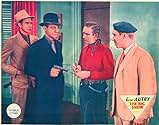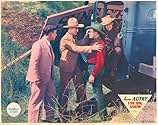AVALIAÇÃO DA IMDb
5,7/10
313
SUA AVALIAÇÃO
Adicionar um enredo no seu idiomaAt the Texas Centennial in Dallas Autry confuses two girls by being himself and his own stunt double.At the Texas Centennial in Dallas Autry confuses two girls by being himself and his own stunt double.At the Texas Centennial in Dallas Autry confuses two girls by being himself and his own stunt double.
- Direção
- Roteiristas
- Artistas
The Jones Boys
- Singers
- (as Jones Boys)
The Beverly Hillbillies
- Musicians
- (as Beverly Hill Billies)
The Light Crust Doughboys
- Musicians
- (as Light Crust Dough Boys)
Jack O'Shea
- Henchman Joe
- (as Jack O'Shay)
Avaliações em destaque
Gene Autry is the stunt double for a conceited western star and has to impersonate him after the actor bails out of a big personal appearance at the Texas Centennial, not knowing that the reason star went on vacation was to avoid paying his gambling debts. Gene gets in way over his head when he turns out to be a bigger hit than expected and gangsters show up to collect their money.
A pleasant, fictionalized account of how Gene Autry became a star, The Big Show offers an irresistible glimpse at the duties that befall a Saturday matinée western star. Despite a loose plot, it's really a lot of fast-paced, tongue-in-cheek fun.
Autry sings some great songs and along with sidekick Smiley Burnette, joins three legendary western groups, The Sons Of The Pioneers (with Roy Rodgers), The Light Crust Doughboys (a personal favorite), and The Beverly Hill Billies. Max Terhune and his dummy even show up for a quickie appearance. Sadly, The Doughboys and the singing group The Jones Boys are deleted from most, if not all video prints.
Although not really much of a western, Autry fans should be satisfied.
A pleasant, fictionalized account of how Gene Autry became a star, The Big Show offers an irresistible glimpse at the duties that befall a Saturday matinée western star. Despite a loose plot, it's really a lot of fast-paced, tongue-in-cheek fun.
Autry sings some great songs and along with sidekick Smiley Burnette, joins three legendary western groups, The Sons Of The Pioneers (with Roy Rodgers), The Light Crust Doughboys (a personal favorite), and The Beverly Hill Billies. Max Terhune and his dummy even show up for a quickie appearance. Sadly, The Doughboys and the singing group The Jones Boys are deleted from most, if not all video prints.
Although not really much of a western, Autry fans should be satisfied.
The Big Show is about the most enjoyable to watch of all his movies for several reasons: One, Mr. Autry plays a double role. Two, there is a lot of clever stunt work, including the famous under the coach and handover hand to the horses stunt. Three, The Big Show has a very different plot from the usual Autry Western. Four, The Big Show contains some very listen-able songs. Five, it is really fun to see Roy Rogers when he was still with the Sons of the Pioneers as Leanard Slye. Six, it is also fun to see behind the scenes of movie making, with some back views of the Republic lot. Seven, since this is an earlier Autry entry, Smiley Burnett is Mr. Autry's side kick rather than Pat Butram. Eight, it is exciting to see the Texas Centennial Celebration as a background. All in all, this is one is really fun.
The likable Gene Autry plays a dual role and has some good opportunities to use his variety of talents in this enjoyable B-Western. The story is light but entertaining, and it has some good musical numbers plus some comic relief from Smiley Burnette. The Texas Centennial setting also gives it some additional historical interest.
Autry plays both a bad-tempered movie star cowboy and his talented, good-natured stunt double, so the setup offers some good lighter moments in its look at the movie industry. The story starts with the stunt double filling in for the star at a public appearance, with numerous complications arising from there. Autry gets many opportunities to sing, and there are also some good action sequences.
Most of it works pretty well, because it generally allows Autry to use his strengths. Burnette also gets some good moments, and while the story is mostly used to showcase Autry and the other musical entertainment, it works too as a way of pulling things together.
Autry plays both a bad-tempered movie star cowboy and his talented, good-natured stunt double, so the setup offers some good lighter moments in its look at the movie industry. The story starts with the stunt double filling in for the star at a public appearance, with numerous complications arising from there. Autry gets many opportunities to sing, and there are also some good action sequences.
Most of it works pretty well, because it generally allows Autry to use his strengths. Burnette also gets some good moments, and while the story is mostly used to showcase Autry and the other musical entertainment, it works too as a way of pulling things together.
This was almost a guilty pleasure to like. Gene Autry plays.. Gene Autry, a stunt double for the famous cowboy Tom Ford in his movies. When Ford skips town to go fishing, his agent is in a pickle as Ford is scheduled to work the Texas National Exposition1 The agent gets a brilliant idea to send Autry instead, since they are EXACTLY alike. Well almost.. You see when Autry arrives in Dallas for the fair, he is caught singing and is put on the fair's radio for all to hear! This radio station is broadcast everywhere! Everyone hears it! The Hollywood studio where Ford works is amazed and wants to book singing cowboy pictures! Problem is.. Other people hear it too.. Like underworld types Ford owes money to and, well, Ford himself! Again, I have no idea why I found this as enjoyable as it was. Probably the main thing was the originality's of the darn thing. I mean, we find out how cowboy films are made! I wonder if Gene Autry, who is playing a stunt man, had a stunt man for his stunt scenes? (He risked life and death though, playing certain "danger" scenes in front of a laughably fake screen). I also loved the fact that they shot ½ the movie at the actual fair itself. I guess they had a wild west show there. LOVE the song he sings at the show when he sings about shooting his injured horse, Champion. I mean, THAT'S ENTERTAINMENT!
A lot of fun as long as you're not expecting a traditional formula Western. There're more imaginative set-ups in this Republic oater than in most A-pictures. Catch the Light Crust Boys as they roll down the road, or the talking horse a couple decades before Mr. Ed, or a mustachioed Gene acting mean and nasty. No, there's no real plot, but the pace is brisk from one lively set-up to the next. And whose great idea was it to film at the new Texas state fair, a backdrop like no other. Those live panoramas are a taste of big screen pageantry before the big screen. All in all, it's a great little peek at popular history and Art Deco. Then too, catch the clever little spoof of movie-making and tyrannical studio heads. I love the movie love scene that immediately becomes a hate scene once the cameras stop rolling. I guess my one complaint is with the movie as a driver's manual-- Driving down the wrong side of a two-lane highway is not, I repeat Not, a good way to deliver lunch. Anyway, the diverse story elements are neatly combined into a highly entertaining 71 minutes, programmer or no programmer. Thanks Western Channel and Autry Enterprises for the full restoration.
Você sabia?
- CuriosidadesAlmost all the scenes were filmed on location at the (then) brand-new Fair Park in Dallas, TX, which served as the location of the 1936 Texas Centennial and has served as the location of the Texas State Fair since. Many of the buildings in the film still exist in what has been called the largest collection of art deco buildings in the world. Also seen is the Gulf Radio Studios building (this is not the WRR Studios; WRR is the only city-owned radio station in the country and still broadcasts from new studios adjacent to Science Place II). The lagoon was pretty barren back then, and Dallas trolley cars which served downtown at the time had just been expanded to Fair Park to service the Centennial. The Cotton Bowl, which was constructed in 1930 and renamed The Cotton Bowl for the Centennial, is seen briefly in the background as Gene Autry rides out of the Cavalcade set in the chase scene.
- Erros de gravaçãoThe Light Crust Doughboys and The Jones Boys appear in the credits, but do not appear in the shortened (54 minutes) version, but along with some additional action they appear in the original (71 minutes) movie.
- Citações
Lee Wilson: Oh why was I ever born?
Gene Autry: Now this is no time for riddles.
- ConexõesFeatured in Gene Autry: White Hat, Silver Screen (2007)
- Trilhas sonorasThe Martins and the Coys
(1936) (uncredited)
Music and Lyrics by Ted Weems and Al Cameron
Performed by Gene Autry, Smiley Burnette and The Beverly Hillbillies
Principais escolhas
Faça login para avaliar e ver a lista de recomendações personalizadas
Detalhes
- Data de lançamento
- País de origem
- Idioma
- Também conhecido como
- The Big Show
- Locações de filme
- Fair Park, Dallas, Texas, EUA(1936 Texas Centennial Exposition)
- Empresa de produção
- Consulte mais créditos da empresa na IMDbPro
- Tempo de duração1 hora 11 minutos
- Cor
- Proporção
- 1.37 : 1
Contribua para esta página
Sugerir uma alteração ou adicionar conteúdo ausente






























